Maeve O’Meara goes in search of the fresh green flavors of Lebanese food and finds the biggest mound of fresh parsley being chopped for use in falafel, the delicious fried snacks made from chickpeas that go so well with creamy hummus and smokey eggplant dip baba ghanoush and which Aussies have taken to with gusto.
Maeve journeys into one of her favorite big Middle Eastern emporiums with master chef Greg Malouf (of Melbourne’s acclaimed Momo restaurant) to discover how to choose the best tahini, yoghurt, bulgur, chickpeas and spice mixes for use in the Lebanese kitchen.
Maeve’s friend Jinan Afiouny discusses the concept of the many delicious dishes that make up mezze ("think Spanish tapas or Italian antipasto but bigger, better and more delicious!" she says) and young chef Katia Faraj makes a really simple baba ghanoush. Next, a visit with friend Samira Saab whose tabbouleh is legendary and who has simple tips on making it taste amazing, then to butcher Ahmad Fettayleh who talks about the lamb mince speciality mixed with fresh herbs and spices called kofta.
Maeve joins pioneering restaurateur Fouad Sayed for a barbeque with kofta and learns the secret to all good Lebanese cooking is "the touch of the hand". We see the incredible process by which Lebanese bread is made with Elias Moawad, and we’re introduced to the very different, very delicious Lebanese style pizzas with Sam Fakoury. Greg Malouf then bakes the most fabulous Tasmanian salmon with a tarator sauce and salad. To finish, we have a rundown of the incredible range of sweets with young pastry chef Rabih Chami.
Click here for the recipes featured in this episode.
About Lebanon
- Menu
Lebanon, officially the Republic of Lebanon, is a country in Western Asia, on the eastern shore of the Mediterranean Sea. It is bordered by Syria to the north and east, and Israel to the south.
Lebanon's location at the crossroads of Asia, Europe, and Africa, Lebanon has been shaped by many civilizations throughout history. Its position as a meeting point for diverse peoples is evident in the extraordinary richness of its archaeological sites and historical monuments. From Stone Age settlements to Phoenician city-states, from Roman temples to rock-cut Christian hermitages, from Crusader Castles to Mamluke mosques and Ottoman hammams, the country's historical sites are a true encyclopedia of ancient and modern world history.
Modern Lebanese society is characterized by this same cultural diversity. Modern-day Lebanon is a country of diverse cultures, traditions, and religions interwoven through time. It is this unique diversity which both fascinates and delights its visitors.
Ancient Lebanon
The earliest known settlements in Lebanon date back to earlier than 5000 BCE. In Byblos, which is considered to be the oldest continuously inhabited city in the world, archaeologists have discovered remnants of prehistoric huts with crushed limestone floors, primitive weapons, and burial jars which are evidence of the Neolithic and Chalcolithic fishing communities who lived on the shore of the Mediterranean Sea over 8,000 years ago.
The coastal plain of Lebanon is the historic home of a string of coastal trading cities of Semitic culture, which the Greeks termed Phoenicia, whose maritime culture flourished there for more than 5000 years.
Ancient ruins in Berytus (Beirut), Sidon, Sarepta (Sarafand), and Tyre show a civilized nation, with urban centers and sophisticated arts. Present-day Lebanon was a cosmopolitan center for many nations and cultures. Its people roamed the Mediterranean seas, skilled in trade and in art, and founded trading colonies. The Phoenicians were the first state-level society to make extensive use of the alphabet. The Phoenician phonetic alphabet is generally believed to be the ancestor of almost all modern alphabets, although it did not contain any vowels (these were added later by the Greeks). From a traditional linguistic perspective, they spoke Phoenician, a Canaanite dialect.
During the early Iron Age, in around 1200 BCE an unknown event occurred, historically associated with the appearance of the Sea Peoples from the north. They weakened and destroyed the Egyptians and the Hittites respectively. In the resulting power vacuum, a number of Phoenician cities rose as significant maritime powers.
Masters of the art of navigation, they founded colonies wherever they went in the Mediterranean Sea (specifically in Cadiz, Cyprus, Rhodes, Crete, and Carthage) and established trade routes to Europe and western Asia. These colonies and trade routes flourished until the invasion of the coastal areas by the Assyrians.
Phoenicia maintained an uneasy tributary relationship with the neo-Assyrian and neo-Babylonian empires; it was conquered outright by the Achaemenid dynasty of Persia, which organized it as a satrapy. It was added to the empire of Alexander the Great, who notably conquered Tyre (332 BC) by extending a still-extant causeway from the mainland in a seven-month effort. It fell to the Seleucid Empire after Alexander's death. The area was conquered by the Roman Empire in the first century and remained Roman until the advent of the Caliphate.
Christianity was introduced to Phoenicia from neighboring Galilee soon after the time of Jesus of Nazareth; the Arab advances brought Islam soon after the death of Muhammad. Muslim influence increased greatly in the seventh century when the Umayyad capital was established at nearby Damascus in Syria.
Back to Menu  |
Middle Ages & Early Modern Era
The Arabs considered the country an undifferentiated part of Bilad ash-Sham which eventually translated into Greater Syria. Before the Arab conquest, the area had been under successive rule of the Persians, Ancient Romans and Byzantines. A weakened Byzantine Empire allowed the expansion of the Arab Empire into Lebanon. The Arabs controlled the area through several dynasties. Europeans, Mamluks, and other groups fought over the territory, but the Ottoman Empire finally gained control of Lebanon.
Arab Rule (660-1258):
The followers of Muhammad, the Prophet of Islam, embarked on a movement to establish their religious and civil control throughout the eastern Mediterranean from their base in the Arabian Peninsula. Their determination to conquer other lands resulted both from economic necessity and from religious beliefs.
Arab rule under the Umayyad dynasty (660-750) and Abbasid dynasty (750-1258) had a profound impact on the eastern Mediterranean area and, to a great degree, was responsible for the composition of modern Lebanese society. During this period some of the Arab tribes settled in the Lebanese and Syrian coastal areas. It was also during this period that Lebanon became a refuge for various ethnic and religious groups. The mountainous territory of Mount Lebanon has long been a shelter for minority and persecuted groups, including its historic Maronite Christian majority along with Druze, and local Shi'a Muslims.
Under the Abbasids, philosophy, literature, and the sciences received great attention, especially during the caliphate of Harun al Rashid and that of his son, Al Mamun. Lebanon made a notable contribution to this intellectual renaissance. The physician Rashid ad Din, the jurist Al Awazi, and the philosopher Qusta ibn Luqa were leaders in their respective disciplines. The country also enjoyed an economic boom in which the Lebanese harbors of Tyre and Tripoli were busy with shipping as the textile, ceramic, and glass industries prospered. Lebanese products were sought after not only in Arab countries but also throughout the Mediterranean Basin.
Holy Crusades:
During the Middle Ages, Lebanon was heavily involved in the Crusades. Lebanon was in the main path of the First Crusade's advance on Jerusalem. Later, Frankish nobles occupied present-day Lebanon as part of the southeastern Crusader States. The southern half of present-day Lebanon formed the northern march of the Kingdom of Jerusalem; the northern half was the heartland of the County of Tripoli.
Although Saladin eliminated Christian control of the Holy Land around 1190 CE, the Crusader states in Lebanon and Syria were better defended. Muslim control of Lebanon was reestablished in the late 13th century under the Mamluk sultans of Egypt.
Mamluk Rule (1282-1516):
The Mamluks were Turkoman slaves from the area east of the Caspian Sea and Circassian slaves from the Caucasus Mountains between the Black Sea and Caspian Sea. They were brought in by the Muslim Ayyubid sultans of Egypt to serve as their bodyguards. One of these slaves, Muez-Aibak, assassinated the Ayyubid sultan, Al Ashraf Musa, in 1252 and founded the Mamluk sultanate, which ruled Egypt and Syria for more than two centuries.
The Mamluks indirectly fostered relations between Europe and the Middle East even after the fall of the Byzantine Empire. The Europeans, accustomed to luxury items from the Middle East, strongly desired both its raw materials and its manufactured products, and the people of the Middle East wished to exploit the lucrative European market. Beirut, favored by its geographical location, became the center of intense trading activity. Despite religious conflicts among the different communities in Lebanon, intellectual life flourished, and economic prosperity continued until Mamluk rule was ended by the Ottoman Turks.
Ottoman Turks Rule (1120-1923):
The Ottoman Turks formed an empire starting from the 14th century which came to encompass the Balkans, Middle east and North Africa. The Ottoman sultan, Selim I (1516–20), after defeating the Persians, conquered the Mamluks. His troops, invading Syria, destroyed Mamluk resistance in 1516 at Marj Dabaq, north of Aleppo.
During the conflict between the Mamluks and the Ottomans, the amirs of Lebanon linked their fate to that of Ghazali, governor (pasha) of Damascus. He won the confidence of the Ottomans by fighting on their side at Marj Dabaq and, apparently pleased with the behavior of the Lebanese amirs, introduced them to Salim I when he entered Damascus. Salim I, moved by the eloquence of the Lebanese ruler Amir Fakhr ad Din I (1516–44), decided to grant the Lebanese amirs a semiautonomous status. The Ottomans, through two great Druze feudal families, the Ma'ans (1120-1697) and the Shihabs (1697-1842), ruled Lebanon until the middle of the 9th century.
It was during Ottoman rule that the term Greater Syria was coined to designate the approximate area included in present-day Lebanon, Syria, Jordan, and Israel/Palestine. Ottoman control was uncontested during the early modern period, but the Lebanese coast became important for its contacts and trades with Venice and other Italian city-states.
Back to Menu  |
Modern Lebanon
Lebanon was part of the Ottoman Empire for over 400 years. By the end of World War I, famine had killed an estimated 100,000 people in Beirut and Mount Lebanon—about 30% of the total population. Following the collapse of the Ottoman Empire after World War I, the five provinces that comprise modern Lebanon became a part of the French Mandate.
The French expanded the borders of Mount Lebanon, which was mostly populated by Maronite Catholics and Druze, to include more Muslims. In September 1926, France formed the Lebanese Republic.
Independence & the Arab-Israeli War:
Lebanon gained independence in 1943, while France was occupied by Germany, and established a unique political system, known as confessionalism, a power-sharing mechanism based on religious communities. Lebanon's unwritten National Pact of 1943 required that its president be Maronite Christian, its speaker of the parliament to be a Shiite Muslim, its prime minister be Sunni Muslim, and the deputy speaker of Parliament and the deputy prime minister be Greek Orthodox. Bechara El Khoury who became independent Lebanon first President and Riad El-Solh, who became Lebanon's first prime minister, are considered the founders of the modern Republic of Lebanon and are national heroes for having led the country's independence.
The allies kept the region under control until the end of World War II. The last French troops withdrew in 1946. Lebanon's history since independence has been marked by alternating periods of political stability and turmoil interspersed with prosperity built on Beirut's position as a regional center for finance and trade.
In May 1948, Lebanon supported neighboring Arab countries against Israel in the Arab-Israeli War. While some irregular forces crossed the border and carried out minor skirmishes against Israel, it was without the support of the Lebanese government, and Lebanese troops did not officially invade. Lebanon agreed to support the forces with covering artillery fire, armored cars, volunteers and logistical support.
During the war, some 100,000 Palestinians fled to Lebanon, and Israel did not permit their return at the end of hostilities. Palestinians, previously prevented from working at all due to denial of citizenship, are now forbidden to work in some 20 professions after liberalization laws. Today, more than 400,000 refugees remain in limbo, about half in camps.
Lebanese Civil War & the PLO:
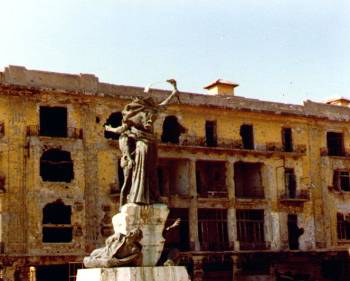 In 1975, civil war broke out in Lebanon. The Lebanese Civil War lasted fifteen years, devastating the country's economy, and resulting in massive loss of human life and property. It is estimated that 150,000 people were killed and another 200,000 wounded. Some 900,000
people, representing one-fifth of the pre-war population, were displaced from their homes. The war ended in 1990 with the signing of the Taif Agreement and parts of Lebanon were left in
ruins
In 1975, civil war broke out in Lebanon. The Lebanese Civil War lasted fifteen years, devastating the country's economy, and resulting in massive loss of human life and property. It is estimated that 150,000 people were killed and another 200,000 wounded. Some 900,000
people, representing one-fifth of the pre-war population, were displaced from their homes. The war ended in 1990 with the signing of the Taif Agreement and parts of Lebanon were left in
ruins
Before the Lebanese Civil War (1975–1990), the country experienced a period of relative calm and prosperity, driven by tourism, agriculture, and banking. Because of its financial power and diversity, Lebanon was known in its heyday as the "Switzerland of the East". It attracted large numbers of tourists, such that the capital Beirut was referred to as "Paris of the Middle East". However, the war devastated the country's economy, and resulted in massive loss of human life and property. It is estimated that 150,000 people were killed and another 200,000 wounded. Some 900,000 people, representing one-fifth of the pre-war population, were displaced from their homes. The war ended in 1990 with the signing of the Ta'if Agreement and parts of Lebanon were left in ruins. At the end of the war, there were extensive efforts to revive the economy and rebuild national infrastructure.
During the Lebanese Civil War, the Palestine Liberation Organization (PLO) used Lebanon to launch attacks against Israel. Lebanon was twice invaded and occupied by the Israel Defense Forces (IDF) in 1978 and 1982, with the PLO expelled in the second invasion. Israel remained in control of Southern Lebanon until 2000, when there was a general decision, led by Israeli Prime Minister Ehud Barak, to withdraw because of continuous attacks executed by Hezbollah, and a belief that the violence would diminish and dissolve without the Israeli presence in Lebanon. The UN determined that the withdrawal of Israeli troops beyond the blue line was in accordance with UN Security Council Resolution 425, although a border region called the Shebaa Farms is still disputed. Hezbollah declared that it would not stop its operations against Israel until this area was liberated.
Present Day:
On February 14, 2005, former Prime Minister Rafiq Hariri was assassinated in a car-bomb attack which killed 21 and wounded 100. On February 21, 2005, tens of thousand Lebanese protestors held a rally at the site of the assassination calling for the withdrawal of Syria's peacekeeping forces and blaming Syria and the pro-Syrian president Lahoud for the murder. In a joint statement U.S. President Bush and French president Chirac condemned the killing and called for full implementation of UNSCR 1559. Under increased international pressue, Syria withdrew the remainder of its military forces in April 2005. In May-June 2005, Lebanon held its first legislative elections since the end of the civil war free of foreign interference, handing a majority to the bloc led by Sa'ad Hariri, the slain prime minister's son.
Until July 2006, Lebanon enjoyed considerable stability, Beirut's reconstruction was almost complete, and increasing numbers of tourists poured into the nation's resorts. Then, the month-long 2006 war between Israel and Hezbollah caused significant civilian death and heavy damage to Lebanon's civil infrastructure.
Hezbollah is a Shi'a Muslim militant group and political party based in Lebanon and leads the March 8 Alliance, which withdrew from the government in January 2011 over its refusal to reject the Special Tribunal for Lebanon. It receives financial and political support from Iran and Syria, and its paramilitary wing is regarded as a resistance movement throughout much of the Arab and Muslim worlds. Multiple countries, including predominantly-Sunni Arab countries such as Saudi Arabia, Egypt and Jordan, have condemned Hezbollah's actions. The United States, the Netherlands, United Kingdom, Egypt, Israel, Australia, and Canada classify Hezbollah as a terrorist organization, in whole or in part.
Inspired by the popular revolts that began in late 2010 against dictatorships across the Middle East and North Africa, marches and demonstrations in Lebanon were directed instead against sectarian politics. Protesters saw the country's religious sectarian politics as the primary cause of Lebanon's anemic government. The first protests in late February 2011, although limited in size, gained some traction.
Today, Lebanon is known for its unique efforts in the Middle East to guarantee civil rights and freedom to its citizens, ranking first in the Middle East and 26th worldwide (out of 66 countries) in the The World Justice Project's Rule of Law Index 2011.
Economy:
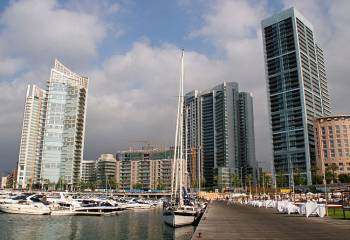 Lebanon's economy and markets are best described as a developing economy. The private sector contributes to around 75% of aggregate demand. Lebanon has the largest proportion of skilled labor among Arab States.
Lebanon's economy and markets are best described as a developing economy. The private sector contributes to around 75% of aggregate demand. Lebanon has the largest proportion of skilled labor among Arab States.
Due to its tightly regulated financial system, Lebanese banks largely avoided the financial crisis of 2007–2010. Lebanon recorded a Human Poverty Index of 7% in the 2009 HDI report which ranks it in the 33rd place in the world. In 2009, despite a global recession, Lebanon enjoyed 9% economic growth and hosted the largest number of tourists in its history; however, by 2011, economic growth had slowed to below average for the region.
Although Lebanon is ideally suited for agricultural activities in terms of water availability and soil fertility, as it possesses the highest proportion of cultivable land in the Arabic speaking world, it does not have a large agricultural sector. Attracting only 12% of the total workforce, agriculture is the least popular economic sector in Lebanon. It contributes approximately 11.7% of the country's GDP, also placing it in the lowest rank compared to other economic sectors. Major produce includes apples, peaches, oranges, and lemons.
Industry in Lebanon is mainly limited to small businesses that reassemble and package imported parts. In 2004, industry ranked second in workforce, with 26% of the Lebanese working population, and second in GDP contribution, with 21% of Lebanon's GDP.
A combination of beautiful climate, many historic landmarks and World Heritage Sites continues to attract large numbers of tourists to Lebanon. In addition, Lebanon's strict financial secrecy and capitalist economy have given it significant, though no longer dominant, economic status among Arab countries. The thriving tourism and banking activities have naturally made the services sector the most important pillar of the Lebanese economy. The majority of the Lebanese workforce (nearly 65%) attains employment in the services sector as a result of the abundant job opportunities. The GDP contribution, accordingly, amounts to roughly 67.3% of the annual Lebanese GDP. However, dependence on the tourism and banking sectors leaves the economy vulnerable to political instability.
Demographics:
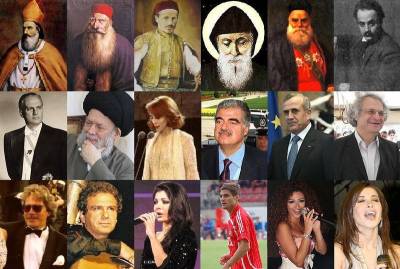 As of July 2010, Lebanon has a total estimated population of 4.02 million people. Lebanon does not collect official census data on ethnic background and therefore is difficult to have an exact demographic analysis of Lebanese society, with the last census conducted by the French Mandate government in 1932.
As of July 2010, Lebanon has a total estimated population of 4.02 million people. Lebanon does not collect official census data on ethnic background and therefore is difficult to have an exact demographic analysis of Lebanese society, with the last census conducted by the French Mandate government in 1932.
Ethnic background is an important factor in Lebanon. The country encompasses a great mix of cultural, religious, and ethnic groups which have been building up for more than 6,000 years. Although most of the population is today considered Arab, in the sense that Arabic is the national language, the ethnic self-designations vary. Whereas the Arabs first reached Lebanon in the 3rd century CE when the Ghassanids (mostly Christian Arabs) migrated north, the majority of the Maronite population is non-Arab in terms of ancestry.
The predominant cultural backgrounds and ancestry of the Lebanese vary from Aramaean (Ancient Syria) to Canaanite (Phoenician), and Greek (Byzantine). Lebanese are overall genetically similar to the other modern Levantine populations, such as the Syrians and the Palestinians.
There are substantial numbers of immigrants from other Arab countries and non-Arab-speaking Muslim countries, such as Iran, and Turkey. Also, recent years have seen an influx of people from Ethiopia and South East Asian countries such as Indonesia, the Philippines, Malaysia, Sri Lanka, as well as smaller numbers of other immigrant minorities, Colombians and Brazilians (of Lebanese descent themselves). Most of these are employed as guest workers. Due to the US-led invasion of Iraq, Lebanon has received a mass influx of Iraqi refugees numbering at around 100,000. The vast majority of them are undocumented, with a large number having been deported or put in prison.
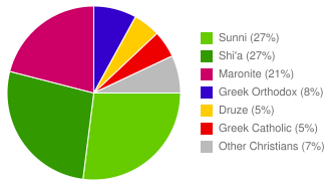 Lebanon's population is estimated to be 59.7% Muslim, 39% Christian, and 1.3% other. Over the past 60 years, there has been a steady decline in the number of Christians as compared to Muslims, due to higher emigration rates among Christians, and a higher birth rate among the Muslim population.
Lebanon's population is estimated to be 59.7% Muslim, 39% Christian, and 1.3% other. Over the past 60 years, there has been a steady decline in the number of Christians as compared to Muslims, due to higher emigration rates among Christians, and a higher birth rate among the Muslim population.
The most recent study conducted by Statistics Lebanon, a Beirut-based research firm, found that approximately 27% of the population was Sunni, 27% Shi'a, 21% Maronite, 8% Greek Orthodox, 5% Druze, 5% Greek Catholic, and 7% other Christian sects. There are 18 state-recognized religious sects—4 Muslim, 12 Christian, 1 Druze, and 1 Jewish.
The majority of Lebanese people speak Lebanese Arabic, while formal Arabic is mostly used in magazines, newspapers, and formal broadcast media. Almost 40% of Lebanese are considered francophone, and 70% of Lebanon's secondary school use French as a second language of instruction. By comparison, English is used as a secondary language in 30% of Lebanon's secondary schools.
Tourism:
The tourism in Lebanon has been historically important to the local economy and remains to this day to be a major source of revenue for Lebanon. Before the Lebanese Civil War, Beirut was widely regarded as "The Paris of the Middle East," often cited as a financial and business hub where visitors could experience the Levantine Mediterranean culture.
Lebanon's diverse atmosphere and ancient history make it an important destination which is slowly rebuilding itself after continued turmoil. Lebanon offers plenty: from ancient Roman ruins, to well preserved castles, limestone caves, historic churches and mosques, beautiful beaches nestled in the Mediterranean Sea, world renown Lebanese cuisine, nonstop nightlife and discothèques, to mountainous ski resorts.
Lebanon has a number of culturally and historically significant UNESCO World Heritage Sites: Anjar, Baalbek, Byblos, Ouadi Qadisha (the Holy Valley) and the Forest of the Cedars of God (Horsh Arz el-Rab), and Tyre.
Significant private investment is currently being made in the modernization and expansion of this sector and international hotel companies have returned to Lebanon. Casino du Liban, which historically constituted a major tourist destination, reopened in 1996. Lebanon is the only country in the Arab world that offers skiing and related winter sports activities. The largest ski resort in the country has been expanded and modernized.
The Government believes that, because of the return of peace and stability to the country and with the development of the necessary infrastructure, tourism will again contribute significantly to Lebanon's economy. In 2009, the New York Times ranked Beirut the #1 travel destination worldwide. In January 2010, the Ministry of Tourism announced that 1,851,081 tourists had visited Lebanon in 2009, a 39% increase from 2008, with hotels reporting an occupancy rate of 95% in 2009. In March 2010, the Lebanon Opportunities review reported that 500,000 tourists had already come to Lebanon since the beginning of the year. The Ministry of Tourism said that more than 2.5 million tourists from the Gulf, Europe, Asia, Africa, and America visited in 2010.
Lebanon's tourism industry also relies on the large number of Lebanese living abroad, who return regularly to the country during the summer season.
Lebanese Cuisine
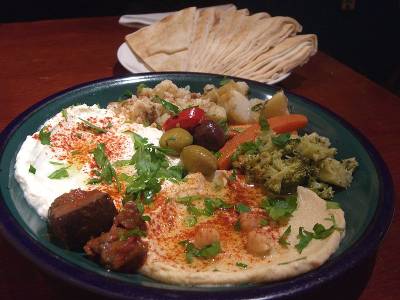 An unique cultural past has helped make Lebanese food the most popular of all Middle Eastern cuisines. Lebanese food is so delicious it is claimed by many countries in the Middle East.
An unique cultural past has helped make Lebanese food the most popular of all Middle Eastern cuisines. Lebanese food is so delicious it is claimed by many countries in the Middle East.
For most of its past, Lebanon has been ruled by foreign powers that have influenced the types of food the Lebanese ate. From 1516 to 1918, the Ottoman Turks controlled Lebanon and introduced a variety of foods that have become staples in the Lebanese diet, such as cooking with lamb. After the Ottomans were defeated in World War I (1914–1918), France took control of Lebanon until 1943, when the country achieved its independence. During this time, the French introduced some of their most widely eaten foods, particularly treats such as flan, a caramel custard dessert dating back to the 16th century, and buttery croissants.
Lebanese cuisine includes an abundance of starches, fruits, vegetables, fresh fish and seafood; animal fats are consumed sparingly. Poultry is eaten more often than red meat, and when red meat is eaten, it is usually lamb on the coast and goat meat in the mountain regions. Lebanese cuisine also includes copious amounts of garlic and olive oil, often seasoned by lemon juice. Rarely does a meal go by in Lebanon which does not include these ingredients.
Most often foods are either grilled, baked or sautéed in olive oil; butter or cream is rarely used other than in a few desserts. Vegetables are often eaten raw or pickled as well as cooked. While the cuisine of Lebanon doesn't boast an entire repertoire of sauces, it focuses on herbs, spices and the freshness of ingredients; the assortment of dishes and combination are almost limitless. The meals are full of robust, earthy flavors and, like most Mediterranean countries, much of what the Lebanese eat is dictated by the seasons.
The Lebanese flat bread (pita) is essential to every Lebanese meal, and can be used to replace the usage of the fork.
Mezze:
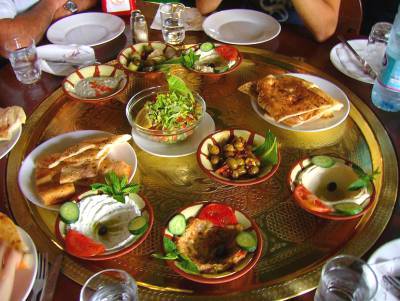 One of the more healthy aspects of Lebanese cuisine is the manner or custom in which their food is often served, which is referred to as Mezze. The mezze has made Lebanese cuisine renowned worldwide. Similar to the tapas of Spain and antipasto of Italy, mezze is an array of up to 30 small dishes placed before the guests creating an array of colors, flavors, textures and aromas. This style of serving food is less a part of family life than it is of entertaining and cafes.
One of the more healthy aspects of Lebanese cuisine is the manner or custom in which their food is often served, which is referred to as Mezze. The mezze has made Lebanese cuisine renowned worldwide. Similar to the tapas of Spain and antipasto of Italy, mezze is an array of up to 30 small dishes placed before the guests creating an array of colors, flavors, textures and aromas. This style of serving food is less a part of family life than it is of entertaining and cafes.
Mezze may be as simple as pickled or raw vegetables, hummus, baba ghanoush and bread, or it may become an entire meal consisting of grilled marinated seafood, skewered meats, a variety of cooked and raw salads (such as the tabouleh and fattoush) and an arrangement of desserts.
Dessert:
Although simple fresh fruits are often served towards the end of a Lebanese meal, there is also dessert and coffee. Known among the great variety of Lebanese sweets, are pastries such as Baklava, the Lebanese ice cream with its oriental flavors, and the Lebanese roasted nuts variety and mixes as part of culture.
Beverages:
Coffee drinking in Lebanon is so much a part of the culture that it is joked that a Lebanese who didn’t drink coffee could lose his nationality. The coffee served is sometimes a variation of Turkish coffee, but a dark type of coffee (see above) is the main type served. Coffee is served throughout the day, at home and in the public cafes. Lebanese coffee is strong, thick and often flavored with cardamom. It is also usually unsweetened and bitter. When guests arrive at one's home, they are invariably persuaded to stay for a coffee, no matter how short their visit.
Arak, an anise-flavored liqueur, is the Lebanese national alcoholic drink and is usually served with the traditional convivial Lebanese meals. Another drink is Lebanese wine, which is now enjoying a worldwide reputation. In fact, Lebanon is among the oldest sites of wine production in the world. Today, Lebanese winemakers have favored French grapes, particularly Cabernet Sauvignon, Merlot and Rhone varietals such as Cinsaut, Carignan and Grenache. However Lebanon has a rich heritage of indigenous grapes which are attracting more attention, for instance Château Musar White is made from a blend of Obaideh (related to Chardonnay) and Merwah (related to Sémillon).
Episodes:
 |
AFRICAN: Wherever you are in Africa, no meal is complete without a starchy porridge known as fufu. |
 |
BRAZILIAN: An exuberant, colorful mix of Portuguese, African and native foods including some from the Amazon. |
 |
CHINESE: Two thirds of households own a wok and use it regularly, but not everyone knows how to use it properly. |
 |
EGYPTIAN: Beans are used extensively and creatively as a source of protein, fibre, and comfort. |
 |
ENGLISH: "Meat & three veg" originated in the UK with dishes like roast beef, steak and kidney pie, and many more. |
 |
FRENCH: The French have elevated food into an art form. Nowhere else is so much attention paid to what people are going to eat and how. |
 |
HUNGARIAN: A fusion of simple peasant food & the elegant, highly developed cuisine from the days of the Austro Hungarian Empire. |
 |
INDIAN: A vibrant, intensely colorful cuisine. Each region of India has its own style of cooking and distinct flavors. |
 |
INDONESIAN: One of the most vibrant and colorful cuisines in the world, full of intense flavor and varied textures. |
 |
ITALIAN: An long-awaited introduction to the kitchens and restaurants of Australia’s top Italian chefs and home cooks. |
 |
JAPANESE: Refined and elegant, its preparation and presentation honed over the centuries so its flavors are pure and delicate. |
 |
JEWISH: While flavors of the Jewish palate are influenced by geography, the constant for Jews all over the world are the Kosher laws. |
 |
KOREAN: Some of the healthiest food on earth, with a near obsession with the fermented vegetable kimchi. |
 |
MALTESE: The rocky island of Malta is home to some beautiful rustic recipes that sing of Mediterranean flavor and freshness. |
 |
MEXICAN: Authentic Mexican food is vibrant, spicy, delicious and fun. It varies according to which region its from. |
 |
MOROCCAN: One of the most cleverly balanced cuisines on earth; spices are used to enhance the flavor of dishes. |
 |
PAKISTANI: Full of marvelous and diverse dishes, it incorporates elements from its neighbors India, Afghanistan and Iran. |
 |
PERSIAN: From simple dips to hearty stews, food preparation is taken very seriously in Iran and is often a labor of love. |
 |
SOUTH AMERICAN: A fantastic fusion of culinary traditions from indigenous Indians, imported Africans, and the Spanish and Portuguese colonist. |
 |
SRI LANKAN: This beautiful spice island is a rich melting pot of every nationality that has visited and traded with it over the years. |
 |
SYRIAN: One of the highlights of Syrian food is mezza, a generous spread of small dishes and the prelude to even more food! |
 |
TURKISH: Nestled between Asia and Europe, Turkish food is an unique and exotic fusion with influences from many countries. |
Contact Us | Shop | Sitemap | Join Our Team | Investors | Advertise | Web Design Services
Community | Foodies' Choice | Meetup Groups | Chat | Blogs | Forums | Submit Your Site | Resources


